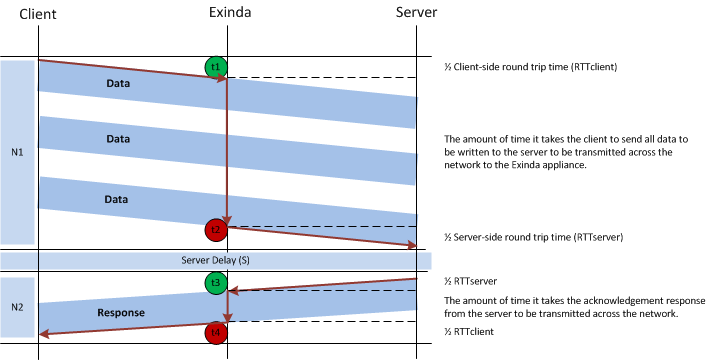Calculating network and server delay in a write transaction
When a client computer sends information to be written to the server, the request and response are tracked to determine how long it takes for the client to send the data to the server, and the server to send an acknowledgment of receiving the data back to the client. The diagram below shows the flowthe network traffic between network objects of information between the client, the Exinda appliance, and the server, and identifies the points in the transaction where time stamps are acquired.

A visual representation of a network write transaction.
Network Delay for Write Request (N1)
- The client sends data to be written on the server, and may be sent in a number of packets.
- When the first data packet starts passing through the Exinda, the time stamp is noted as the beginning of the packet (t1).
- When the end of the last data packet passes through the Exinda, the time stamp is noted (
t2).t2 – t1= The amount of time it takes the client to send data through the Exinda appliance. - The server receives all the data from the client.
Server Delay for Write Request (S)
- There is a very small delay between receiving the data from the client and the acknowledgement that is sent from the Server back to the client. This is the Server delay (S).
Network Delay for Write Response (N2)
- The server’s acknowledgment response to the client that the data has been received is sent.
- When the response passes through the Exinda, the time stamp is noted (
t3). - When the end of the response passes through the Exinda, the time stamp is noted (
t4).t4 – t3= The amount of time it takes the server response to pass through the Exinda appliance. - The client receives the response from the server.
Total Time for Write Transaction
The total transaction time for a Write transaction is calculated as Transaction time = N1 + S + N2 where:
- N1 = ½ RTTclient + (t2 – t1) + ½ RTTserver
- S = (t3 – t2) – RTTserver
- N2 = ½ RTTserver + (t4 – t3) + ½ RTTclient